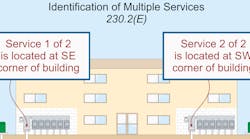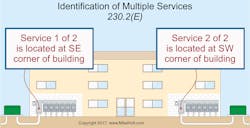Stumped by the Code? NEC Limits on the Number of Service Drops or Service Laterals Allowed
All questions and answers are based on the 2017 NEC.
Underlined text indicates a Code change.
Q. Does the NEC limit the number of service drops or service laterals allowed on a building?
A. A building can only be served by one service drop or service lateral, except as permitted by Sec. 230.2(A) through (D). Note: A “service” is the conductors and equipment for delivering electric power from the electric utility to the premises served [Art. 100]. Types of services provided from the utility include “service drops” and “service laterals.”
(A) Special Conditions. Additional services are permitted for the following:
(1) Fire pumps
(2) Emergency systems
(3) Legally required standby systems Note: A separate service for emergency and legally required systems is permitted only when approved by the authority having jurisdiction [700.12(D) and 701.12(D)].
(4) Optional standby power
(5) Parallel power production systems
(6) Systems designed for connection to multiple sources of supply to enhance reliability. Note: To minimize the possibility of simultaneous interruption, the disconnecting means for the fire pump, emergency system, or standby power system must be located remotely away from the normal power disconnecting means [230.72(B)].
(B) Special Occupancies. By special permission, additional services are permitted for:
(1) Multiple-occupancy buildings where there’s no available space for supply equipment accessible to all occupants, or
(2) A building or other structure so large that two or more supplies are necessary.
(C) Capacity Requirements. Additional services are permitted:
(1) If the capacity requirements exceed 2,000A, or
(2) If the load requirements of a single-phase installation exceed the electric utility’s power capacity, or
(3) By special permission.
Note: Special permission is defined in Art. 100 as “the written consent of the authority having jurisdiction.”
(D) Different Characteristics. Additional services are permitted for different voltages, frequencies, or phases, or for different uses, such as for different electricity rate schedules.
(E) Identification of Multiple Services. If a building is supplied by more than one service, or a combination of feeders and services, a permanent plaque or directory must be installed at each service and feeder disconnecting means location to denote all other services and feeders supplying that building, and the area served by each (see Figure).
Q. Does the Code allow branch-circuit and feeder conductors to be installed in a service raceway containing service conductors?
A. Feeder and branch‑circuit conductors aren’t permitted to be installed in a service raceway containing service conductors [230.7].
Exception No. 1: Grounding electrode conductors or supply‑side bonding jumpers are permitted in a service raceway with service conductors.
Exception No. 2: Conductors used for load management with overcurrent protection are permitted in service raceways with service conductors.
WARNING: Overcurrent protection for the feeder or branch‑circuit conductors can be bypassed or a fault can occur if service conductors are mixed with feeder or branch‑circuit conductors in the same raceway and a fault occurs between the service and feeder or branch‑circuit conductors.
Notes: This rule doesn’t prohibit the mixing of service, feeder, and branch‑circuit conductors in the same service equipment enclosure. This requirement may be the root of the misconception that “line” and “load” conductors aren’t permitted to be installed in the same raceway. It’s true that service conductors aren’t permitted to be installed in the same raceway with feeder or branch‑circuit conductors, but line and load conductors for feeders and branch circuits can be in the same raceway or enclosure.
These materials are provided to us by Mike Holt Enterprises of Leesburg, Fla. To view additional Code training materials offered by this company, visit www.mikeholt.com.





